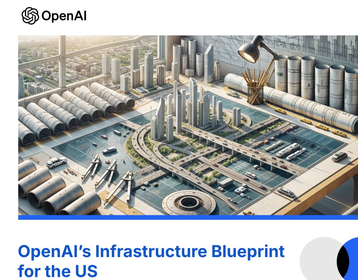With a new administration on the horizon, OpenAI sets out its wishlist
OpenAI has presented an ‘infrastructure blueprint for the US,’ laying out five government changes it said would “catalyze the building of AI infrastructure.”
The previously unpublished paper was expanded upon by Chris Lehane, VP of global affairs at OpenAI, in a talk at the Center for Strategic & International Studies seminar on US leadership in AI.

The first of the five suggestions is to create ‘AI Economic Zones,’ where states can incentivize faster permitting and approvals for AI infrastructure, including data centers, as well as dormant nuclear reactors, new wind farms, and solar arrays.
In return, OpenAI suggests incentivizing states and local communities by allocating a portion of the AI compute to local startups and businesses.
“It could support public universities, it could support the buildout of developer ecosystems so that those communities would really benefit from the economic activity in and around the AI data center,” Lehane said.
Next is the passage of a National Transmission Highway Act, named after the 1956 Interstate Highway Act. Instead of roads, it would expand transmission lines, fiber connectivity, and natural gas pipeline construction.
“If you look at the data center activity that is already taking place in places like Texas and Kansas, you’re seeing this interesting combination oftentimes of some sequestered natural gas but then also bringing on wind and solar,” Lehane said.
Third is government backstops for AI public works, where the government would encourage private investors to fund high-cost energy infrastructure projects by committing to purchase energy and other means that lessen credit risk. This would also include government investment in upskilling workers for AI, data centers, and energy infrastructure.
Then comes the ‘North American Compact for AI,’ where the US and its neighbors would team up to streamline access to capital, supply chains, and talent in a way that supports AI infrastructure construction.
That could expand to a global network of US allies, with Lehane repeatedly pitching the move and other investments as a bulwark against China’s AI ambitions.
Finally, OpenAI suggests using the expertise of the Nuclear Navy, which runs small modular reactors on its submarines, and getting their help on land-based projects. OpenAI CEO Sam Altman is an investor in fast-fission company Oklo, which has signed multiple data center deals.
With President-elect Trump’s priorities unclear, Lehane said all five moves would be bipartisan in nature.
“I’m old enough to remember in the mid-1990s when I actually still had a little bit more hair and I worked in the Clinton White House, Democrats and Republicans came together and worked in a bipartisan way to put in place the Telco Act of 1996 which really served as a catalyst for the development of what was then called the world wide web, which we think of today as the Internet,” he said.
“There was a national strategy that both parties came together on, and that strategy was to make sure that the US was really the epicenter of the digital age, and it succeeded, and so we need to start to think big and act big in the same way that we have done in the past.”
Earlier this month, DCD was first to publish OpenAI’s pitch for 5GW data center clusters in the US. However, the economic and practical viability of such projects is still unknown.
https://www.datacenterdynamics.com/en/news/openai-pitches-ai-economic-zones-for-data-center-permitting-a-national-transmission-highway-act-and-more-government-support/





